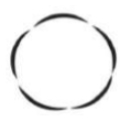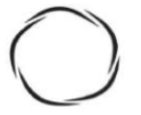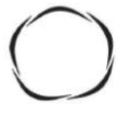The type of placentation show in the given figure is seen in:

1.
Dianthus
2.
Argemone
3.
China rose
4.
Marigold

The given floral diagram can be of:
1. Asparagus
2. Atropa belladonna
3. Mustard
4. Indigofera
Match the columns A and B:
| Column I | Column II | ||
| (a) | Marginal placentation | (i) | Marigold |
| (b) | Axile placentation | (ii) | Dianthus |
| (c) | Parietal placentation | (iii) | Argemone |
| (d) | Free central placentation | (iv) | Chinarose |
| (e) | Basal placentation | (v) | Pea |
| (a) | (b) | (c) | (d) | (e) | |
| 1. | (v) | (iv) | (iii) | (ii) | (i) |
| 2. | (v) | (iii) | (iv) | (i) | (ii) |
| 3. | (iv) | (iii) | (v) | (ii) | (i) |
| 4. | (i) | (v) | (iv) | (iii) | (ii) |
An inferior ovary:
| 1. | is situated on the receptacle above the perianth and androecium. |
| 2. | is positioned below the sites of attachment for perianth and androecium. |
| 3. | forms a hypanthium. |
| 4. | is positioned below the receptacle. |
The type of aestivation seen in Calotropis is represented by:
| 1. |  |
2. |  |
| 3. |  |
4. |  |
The floral diagram shown in the given diagram can be of:
1. A plant that produces a chemical that can disrupt mitotic spindle
2. Deadly night shade
3. Indigofera plant, a source of dye
4. A pulse plant
The region responsible for growth in the length of the root is:
1. A
2. B
3. C
4. D
is the floral formula of
1. Allium
2. Sesbania
3. Petunia
4. Brassica
Keel is the characteristic feature of flower of
(1) tulip
(2) Indigofera
(3) Aloe
(4) tomato
The wheat grain has an embryo with one large, shield-shaped cotyledon known as
(1) epiblast
(2) coleorrhiza
(3) scutellum
(4) coleoptile









